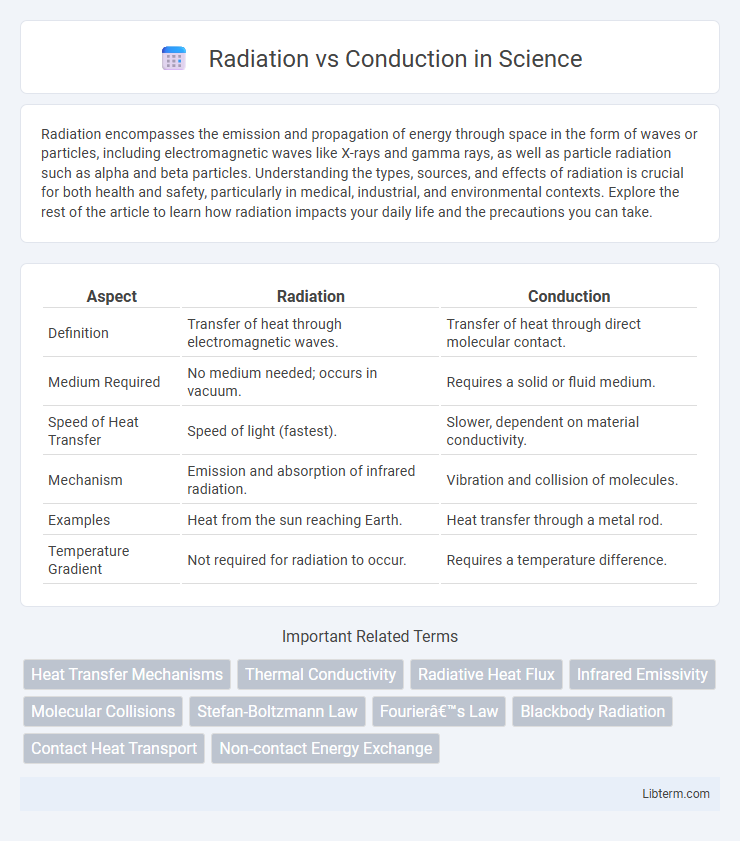Radiation encompasses the emission and propagation of energy through space in the form of waves or particles, including electromagnetic waves like X-rays and gamma rays, as well as particle radiation such as alpha and beta particles. Understanding the types, sources, and effects of radiation is crucial for both health and safety, particularly in medical, industrial, and environmental contexts. Explore the rest of the article to learn how radiation impacts your daily life and the precautions you can take.
Table of Comparison
| Aspect | Radiation | Conduction |
|---|---|---|
| Definition | Transfer of heat through electromagnetic waves. | Transfer of heat through direct molecular contact. |
| Medium Required | No medium needed; occurs in vacuum. | Requires a solid or fluid medium. |
| Speed of Heat Transfer | Speed of light (fastest). | Slower, dependent on material conductivity. |
| Mechanism | Emission and absorption of infrared radiation. | Vibration and collision of molecules. |
| Examples | Heat from the sun reaching Earth. | Heat transfer through a metal rod. |
| Temperature Gradient | Not required for radiation to occur. | Requires a temperature difference. |
Introduction to Heat Transfer
Radiation transfers heat through electromagnetic waves without requiring a medium, making it effective in a vacuum and across space. Conduction involves direct molecular collision within a material, enabling heat flow from high to low temperature regions through solids and stationary fluids. Understanding these fundamental heat transfer modes is essential for designing thermal management systems in engineering and environmental applications.
Defining Radiation and Conduction
Radiation is the transfer of heat energy through electromagnetic waves without requiring a medium, allowing heat to travel through a vacuum. Conduction involves the transfer of heat through direct molecular collision within a solid or between objects in physical contact, relying on temperature gradients. Both processes play crucial roles in thermal energy exchange but operate through fundamentally different mechanisms.
Mechanisms of Radiation
Radiation transfers energy through electromagnetic waves, allowing heat to travel across a vacuum without requiring a medium, unlike conduction which relies on direct molecular collisions within solids or fluids. The mechanism involves the emission of infrared radiation from all objects above absolute zero, with the intensity governed by the Stefan-Boltzmann law and wavelength distribution described by Planck's law. This process enables heat exchange over long distances, such as solar radiation reaching Earth, making radiation a crucial mode of thermal energy transfer in both natural and technological systems.
Mechanisms of Conduction
Conduction is the transfer of heat through direct molecular collisions within a solid or between objects in contact, relying on the vibration and movement of atoms and free electrons to propagate thermal energy. Unlike radiation, which transfers energy through electromagnetic waves without needing a medium, conduction requires physical contact and is most efficient in solids with tightly packed molecules. Key materials facilitating conduction include metals like copper and aluminum due to their high thermal conductivity driven by free electron mobility.
Key Differences Between Radiation and Conduction
Radiation transfers heat through electromagnetic waves without requiring a medium, enabling heat exchange even in a vacuum, whereas conduction relies on direct molecular contact for heat transfer within solids or between touching materials. Radiation involves the emission and absorption of infrared waves, with no mass transfer, while conduction depends on lattice vibrations or free electron movement in materials. The rate of conduction is influenced by material properties such as thermal conductivity, whereas radiation depends on surface emissivity and temperature differences.
Factors Influencing Radiation and Conduction
Radiation is influenced primarily by the temperature of the emitting surface, its emissivity, and the surrounding environment's temperature, with higher emissivity materials radiating more energy. Conduction depends on the thermal conductivity of the material, the cross-sectional area, the temperature gradient across the material, and the thickness of the medium through which heat transfers. Surface texture and the presence of insulating layers significantly impact conduction rates, while radiation varies with surface color and roughness.
Examples of Radiation in Everyday Life
Radiation transfers heat through electromagnetic waves without requiring a medium, such as the warmth felt from the Sun's rays or the heat emitted by a fireplace. Microwave ovens use radiation to heat food by exciting water molecules, demonstrating practical everyday applications. Infrared heaters and the heat from a glowing stove burner also exemplify radiation, highlighting its role in daily thermal energy transfer.
Examples of Conduction in Daily Activities
Conduction occurs in daily activities such as cooking when a pan heats on a stove, transferring heat directly through the metal to the food. Touching a metal spoon left in a hot pot results in heat conduction from the spoon to your hand. Similarly, warming cold feet on a heated floor involves heat transfer through direct contact with the surface.
Advantages and Limitations of Each Method
Radiation transfers heat through electromagnetic waves without requiring a medium, offering advantages in vacuum or transparent environments but limited by its line-of-sight dependency and lower efficiency over long distances. Conduction efficiently transfers heat through direct molecular contact, ideal for solids and materials with high thermal conductivity, though it is ineffective across gaps or in insulating materials. Each method suits different applications based on environmental conditions and material properties, balancing factors like speed, distance, and medium requirements.
Practical Applications: Radiation vs Conduction
Radiation is effectively utilized in solar panels and infrared heaters, where heat transfer occurs through electromagnetic waves without the need for a medium. Conduction is critical in cooking utensils and heat exchangers, relying on direct material contact to transfer thermal energy efficiently. Understanding these mechanisms enhances the design of energy-efficient systems in residential, industrial, and laboratory settings.
Radiation Infographic

 libterm.com
libterm.com